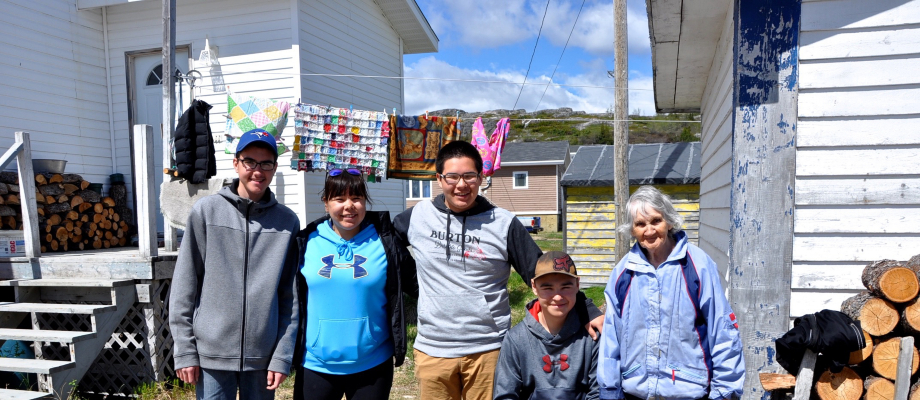 Landscape of Culture
Landscape of Culture
The Agvituk Digital Archive Project
The Agvituk (also spelled Avertok) Digital Archive Project is part of the Tradition and Transition community-based Agvituk Archaeology Project (AAP), which was initiated by the Hopedale community of Nunatsiavut in 2017 and is led by Lisa Rankin. The Hopedale community articulated that they need meaningful access to research results and want community involvement in the archaeology project, preferably in ways that support knowledge exchange between Elders and youth. The Agvituk Digital Archive Project aims to fulfill these requests through the creation of a digital archive of archaeological and community knowledge pertaining to Agvituk and the surrounding area.
Agvituk is a large Inuit whaling site that was an important part of the Inuit-European coastal trade network during the 16th to 18th centuries. After Moravian missionaries set up a mission close to Agvituk at the end of the 18th century, Inuit began settling closer to the mission and eventually abandoned Agvituk. The site has been subject to many archaeological investigations, and artifacts from it are now housed in museums throughout Canada, the United States, and Europe. The site is located within the current boundaries of the Hamlet of Hopedale and remains culturally important to the people of the community, but community members have seen very little of what has been excavated.
The Avertok Digital Archive Project seeks to understand the possible implications for the intellectual property rights of knowledge contributors. Working with archaeologists, heritage professionals, and community knowledge holders, the project applies ethnographic and archaeological methods to develop a community archive of the archaeological and traditional knowledge about Agvituk and the surrounding area. This research aims to: share archaeological research results from the AAP, as well as previous excavations, with the Hopedale community; work with Nunatsiavummiut youth to see how accessible, low-cost technologies can be used to document and share archaeological and traditional knowledge; bring artifacts recovered from Agvituk together so that they can be studied as one collection; and develop guidelines for establishing best practices for archaeological and community knowledge sharing.
I have has visited nine museums, including the museum in Hopedale, to record their collections from Agvituk and the nearby area for the archive. The National Museum of Denmark has also submitted photographs and information of their collection to be used in the archive. At the museums, I have photographed and made 3D models of Nunatsiavummiut objects. I opted for accessible technology to make the 3D models, using an iPad and an attachment called a structure sensor.
Laura has visited the Rooms Museum and Archives in St. John’s, Newfoundland, Chicago, American Museum of Natural History in New York, the Field Museum in Chicago, The Peabody Institute of Archaeology in Andover, the British Museum in London, the Herrnhut Museum of Ethnology in Herrnhut, the Museum of Ethnology in Leipzig, and the Museum of Ethnology in Dresden, and Hopedale Mission National Historic Site in Hopedale to record their collections from Hopedale and the surrounding area. The National Museum of Denmark has also submitted photographs and information of their collection to be used in the archive.
Throughout the project, local Hopedalimiut students Denver Edmunds, Rosie Edmunds, Nicholas Flowers, Mackenzie Frieda, Claire Igloliorte, Halle Lucy, John Piercy, and Ida Semigak were hired to work with me during the summers to interview Elders and community knowledge holders to record traditional knowledge pertaining to the objects and the sites they originated from. Together, they have also done some archaeological survey of these sites. Because the archive will take some time to get up and running, they have worked on small projects to disseminate their research including community presentations, creating content for the Agvituk Archaeology Project Facebook and Instagram pages, blog posts for Day of Archaeology and this website, articles for Them Days Magazine, and a paper in the Canadian Journal of Archaeology, “Strength-Based Approaches to Involving Inuit Youth in Archaeological Research.” The most successful dissemination initiative of this project has been a series of short videos based on community knowledge and the objects stored in museums. These videos can be found on our YouTube channel and the Labrador Stories website.
Student video exploring the excavations of Agvituk and other nearby sites carried out by Junius Bird in the 1930s.
This project is funded by the Tradition and Transition Partnership, Social Science and Humanities Research Council Postdoctoral Fellowship, the Newfoundland and Labrador Provincial Archaeology Office, the Institute for Social and Economic Research, the J. R. Smallwood foundation, and Inuit Pathways.












